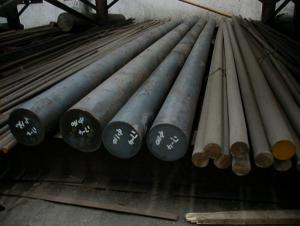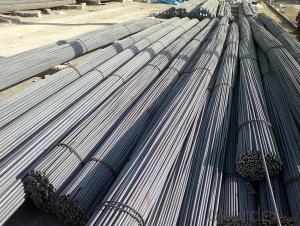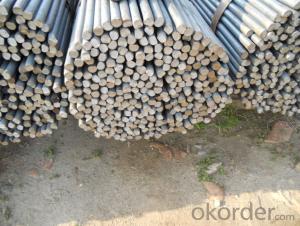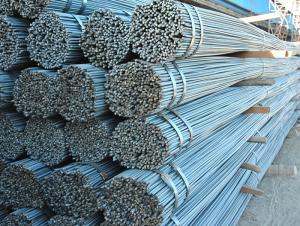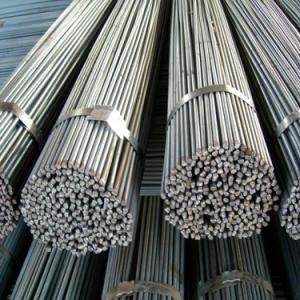Round Bar Hot Rolled High Quality Q195 Q235 8MM-22MM
- Loading Port:
- China Main Port
- Payment Terms:
- TT or LC
- Min Order Qty:
- -
- Supply Capability:
- -
OKorder Service Pledge
OKorder Financial Service
You Might Also Like
Product Description:
OKorder is offering Round Bar Hot Rolled High Quality Q195 Q235 8MM-22MM at great prices with worldwide shipping. Our supplier is a world-class manufacturer of steel, with our products utilized the world over. OKorder annually supplies products to European, North American and Asian markets. We provide quotations within 24 hours of receiving an inquiry and guarantee competitive prices.
Product Applications:
1) Suitable for making various strong cutting tool abrasion resistance, impact resistance.
2) Used to produce all kinds of high hard and super hard saw blade, drill, tap, broach, gear hob and various kinds of milling cutter.
3) Used for advanced punching die, screw die, and the toughness and complicated shape of the punch, etc.
4) Is used for cold forging die and drawing mode, etc.
5) Recommended watchcase factory, screw factory and other cold stamping products industry use.
Product Advantages:
OKorder's Round Bar Hot Rolled High Quality Q195 Q235 8MM-22MM are durable, strong, and resist corrosion.
Main Product Features:
· Premium quality
· Prompt delivery & seaworthy packing (30 days after receiving deposit)
· Corrosion resistance
· Can be recycled and reused
· Mill test certification
· Professional Service
· Competitive pricing
Product Specifications:
1. Grade: GB, JIS, ASTM, EN
2. Grade: Q235, SS400, A36, S235JR
3. Diameter and mass: As below
Diameter | Mass | Diameter | Mass | Diameter | Mass |
(mm) | (kg/m) | (mm) | (kg/m) | (mm) | (kg/m) |
6 | 0.22 | 22 | 2.98 | 53 | 17.30 |
7 | 0.30 | 24 | 3.55 | 56 | 19.30 |
8 | 0.40 | 25 | 3.85 | 60 | 22.20 |
9 | 0.50 | 26 | 4.17 | 63 | 24.50 |
10 | 0.62 | 28 | 4.83 | 65 | 26.00 |
11 | 0.75 | 30 | 5.55 | 70 | 30.20 |
12 | 0.89 | 32 | 6.31 | 75 | 34.70 |
13 | 1.04 | 34 | 7.13 | 80 | 39.50 |
14 | 1.21 | 36 | 7.99 | 85 | 44.50 |
15 | 1.39 | 38 | 8.90 | 90 | 49.90 |
16 | 1.58 | 40 | 9.86 | 95 | 55.60 |
17 | 1.78 | 42 | 10.90 | 100 | 61.70 |
18 | 2.00 | 45 | 12.50 | 120 | 88.85 |
19 | 2.23 | 48 | 14.20 | 140 | 120.93 |
20 | 2.47 | 50 | 15.40 | 150 | 138.82 |
4. Material: Mild Steel
5. Heat treatment of high quality steel:
Fire: Isothermal annealing temperature is 800 ~ 880 °C, with 10 ~ 20 °C, the furnace cooling to about 600 °C, hardness above HB269.
Preheat temperature: 730-730 °C
Quenching temperature: 1190-1210 °C
Tempering temperature: 540-595 °C
Cold drawn, hardness 285 HBS
Cold drawn after annealing condition, hardness 277 HBS
Quenching methods: oil quenching, air cooling or salt bath quenching
FAQ:
Q1: Why buy Materials & Equipment from OKorder.com?
A1: All products offered byOKorder.com are carefully selected from China's most reliable manufacturing enterprises. Through its ISO certifications, OKorder.com adheres to the highest standards and a commitment to supply chain safety and customer satisfaction.
Q2: How do you package the angle steel when shipping?
A2: All goods are packed in bundles with steel strips and shipped by container or break bulk.
Q3: The products are invoicing on theoritical weight or on actual weight?
A3: We can do it in both manners, according to the customers' request.
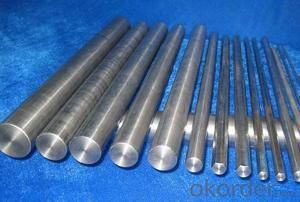
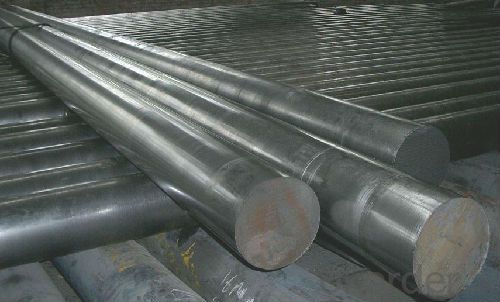
- Q:How do you calculate the weight of a steel round bar based on its volume and density?
- To determine the weight of a steel round bar based on its volume and density, one can utilize the following formula: Weight = Volume x Density Initially, ascertain the volume of the round bar. The volume of a cylinder, which represents the shape of a round bar, can be computed using the subsequent equation: Volume = π x (diameter/2)^2 x length Here, π denotes a mathematical constant that is roughly equivalent to 3.14159, and the diameter and length are the measurements of the round bar. Once the volume is determined, it is necessary to know the density of the steel. The density of steel may differ depending on the type and grade of steel employed. Typically, density is measured in kilograms per cubic meter (kg/m^3) or pounds per cubic inch (lbs/in^3). The density of steel can be found in reference materials or on the internet. Ultimately, the volume should be multiplied by the density to acquire the weight of the steel round bar. Ensure that the units of volume and density are consistent. For instance, if the volume is given in cubic inches and the density is in pounds per cubic inch, the weight will be expressed in pounds. Conversely, if the volume is in cubic meters and the density is in kilograms per cubic meter, the weight will be in kilograms. It is essential to note that this calculation assumes that the round bar is entirely composed of steel and possesses a uniform density throughout its volume. Moreover, this calculation disregards any other factors that may influence the weight, such as impurities or surface finish.
- Q:What is the difference between a rough turned and a centerless ground steel round bar?
- A rough turned steel round bar refers to a steel bar that has been machined to a standard size and shape, typically using a lathe or turning machine. The process involves removing excess material from the bar's surface to achieve the desired diameter and smoothness. The resulting rough turned bar may still have slight imperfections or variations in size and surface finish. On the other hand, a centerless ground steel round bar undergoes a different manufacturing process. Centerless grinding involves feeding the steel bar through two rotating wheels: a grinding wheel and a regulating wheel. The grinding wheel removes material from the bar's surface to achieve a precise diameter, while the regulating wheel controls the bar's feed rate. This process ensures tight tolerances, excellent surface finish, and a uniform diameter along the entire length of the bar. In summary, the main difference between a rough turned and a centerless ground steel round bar lies in the manufacturing process and the resulting quality. While a rough turned bar is machined to a standard size and shape with some imperfections, a centerless ground bar undergoes a more precise grinding process to achieve a highly accurate diameter, excellent surface finish, and consistent dimensions throughout the bar.
- Q:Can steel round bars be used in the manufacturing of garden tools?
- Absolutely, garden tools can certainly incorporate steel round bars in their manufacturing process. Steel, known for its versatility and durability, is widely employed in the production of diverse tools, particularly those used in gardens. Shovels, rakes, hoes, and pruning shears are just a few examples of garden implements that can be crafted using steel round bars, thanks to their malleability. The exceptional strength and resilience of steel render it perfectly suited for enduring the strenuous demands of outdoor activities like digging, cutting, and scraping. Moreover, steel can be effortlessly honed and maintained, ensuring that the garden tools retain their efficacy and longevity.
- Q:Can steel round bars be bent or formed into different shapes?
- Yes, steel round bars can be bent or formed into different shapes. Steel is a highly malleable material, which means it can be easily shaped without breaking or cracking. To bend or form steel round bars, various methods can be used, such as heating the bars to make them more pliable or using specialized tools like hydraulic benders or presses. The degree to which steel round bars can be bent or formed depends on factors such as the thickness and composition of the steel, as well as the specific shape or angle desired. Overall, steel round bars offer a versatile option for creating a wide range of shapes and structures in various industries, including construction, automotive, and manufacturing.
- Q:Are steel round bars prone to deformation?
- Steel round bars are generally not prone to deformation when they are properly manufactured and used within their intended limits. Steel is known for its high tensile strength and durability, making it resistant to bending or warping under normal circumstances. However, it is important to note that excessive force or improper handling can still cause deformation in steel round bars. Overloading, incorrect storage conditions, or inappropriate machining techniques can all contribute to bending or twisting of the bars. Therefore, it is crucial to follow recommended guidelines and industry standards to ensure the integrity and longevity of steel round bars.
- Q:Can steel round bars be used in the production of packaging equipment?
- Steel round bars are indeed a versatile option for the production of packaging equipment. Their exceptional strength and durability make them highly favored in various industries. When it comes to packaging equipment, these round bars serve multiple purposes, such as offering structural support, reinforcement, or acting as components in the machinery's moving parts. The steel's impressive hardness and resistance to wear and tear make it ideal for handling heavy loads and ensuring uninterrupted operation. Moreover, steel round bars can be easily machined, welded, or modified to precisely meet the specific requirements of the packaging equipment. All in all, steel round bars are a dependable and widely utilized material in the manufacturing of packaging equipment.
- Q:Can steel round bars be threaded or machined?
- Steel round bars are capable of being threaded or machined. Threading involves the creation of internal or external threads on the surface of a steel round bar, enabling it to connect or fasten to other components. Meanwhile, machining entails the utilization of diverse cutting tools and techniques to eliminate material from the steel round bar, thereby shaping it into the desired form or size. Consequently, both threading and machining can be employed on steel round bars to fulfill specific requirements and applications, including the production of threaded rods, bolts, or customized components.
- Q:Can steel round bars be used for making valves or fittings?
- Yes, steel round bars can be used for making valves or fittings. Steel is a common material choice for valves and fittings due to its strength, durability, and resistance to corrosion. Steel round bars can be machined or forged into the desired shape for valves or fittings, ensuring that they meet the necessary specifications and requirements. Additionally, steel round bars can be heat-treated to enhance their mechanical properties and make them suitable for high-pressure or high-temperature applications. Overall, steel round bars are a versatile and reliable material option for manufacturing valves or fittings.
- Q:What are the different heat treatment processes used for steel round bars?
- Some of the different heat treatment processes used for steel round bars include annealing, quenching, tempering, normalizing, and hardening. Each process involves heating and cooling the steel to alter its properties such as hardness, strength, and ductility. Annealing involves heating the steel and slowly cooling it to relieve internal stresses and improve machinability. Quenching involves rapidly cooling the steel to increase its hardness. Tempering is a process that involves reheating the quenched steel to reduce brittleness and improve toughness. Normalizing is similar to annealing but involves air cooling instead of slow cooling. Hardening is a process that involves heating the steel and then rapidly cooling it to increase its hardness and strength.
- Q:What are the advantages of using tool steel round bars?
- There are several advantages to using tool steel round bars. Firstly, tool steel round bars offer exceptional hardness and wear resistance. This makes them ideal for applications where the material needs to withstand high levels of stress, such as in the manufacturing of cutting tools, dies, and molds. The hardness of tool steel also allows for precise machining, resulting in accurate and intricate shapes. Secondly, tool steel round bars have excellent toughness and impact resistance. This means that they can withstand heavy-duty applications without breaking or cracking. This makes them suitable for use in demanding industries such as aerospace, automotive, and construction. Furthermore, tool steel round bars are known for their high temperature resistance. They can maintain their hardness and strength even under extreme heat conditions. This feature is particularly advantageous in applications where the material is exposed to high temperatures, such as in forging or heat treating operations. Another advantage of using tool steel round bars is their dimensional stability. They have a low coefficient of thermal expansion, meaning they do not undergo significant dimensional changes when exposed to temperature variations. This makes them highly reliable and predictable in various operating conditions. Moreover, tool steel round bars can be easily machined and heat treated to achieve specific properties. This versatility allows manufacturers to tailor the material to their specific needs, enhancing the overall performance of the end product. Lastly, tool steel round bars are readily available and cost-effective. They are widely produced and stocked by suppliers, making them easily accessible for various applications. Additionally, their long lifespan and resistance to wear and tear contribute to their cost-effectiveness. In conclusion, the advantages of using tool steel round bars include exceptional hardness, toughness, high temperature resistance, dimensional stability, versatility, availability, and cost-effectiveness. These properties make them a preferred choice in industries where durability, precision, and reliability are crucial.
1. Manufacturer Overview |
|
|---|---|
| Location | |
| Year Established | |
| Annual Output Value | |
| Main Markets | |
| Company Certifications | |
2. Manufacturer Certificates |
|
|---|---|
| a) Certification Name | |
| Range | |
| Reference | |
| Validity Period | |
3. Manufacturer Capability |
|
|---|---|
| a)Trade Capacity | |
| Nearest Port | |
| Export Percentage | |
| No.of Employees in Trade Department | |
| Language Spoken: | |
| b)Factory Information | |
| Factory Size: | |
| No. of Production Lines | |
| Contract Manufacturing | |
| Product Price Range | |
Send your message to us
Round Bar Hot Rolled High Quality Q195 Q235 8MM-22MM
- Loading Port:
- China Main Port
- Payment Terms:
- TT or LC
- Min Order Qty:
- -
- Supply Capability:
- -
OKorder Service Pledge
OKorder Financial Service
Similar products
New products
Hot products
Related keywords
